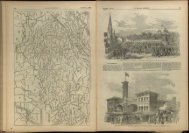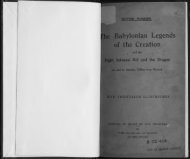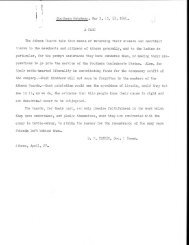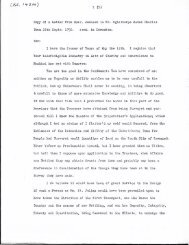THE SHE KING; OR, THE BOOK OF ANCIENT POETRY
THE SHE KING; OR, THE BOOK OF ANCIENT POETRY
THE SHE KING; OR, THE BOOK OF ANCIENT POETRY
You also want an ePaper? Increase the reach of your titles
YUMPU automatically turns print PDFs into web optimized ePapers that Google loves.
If 1<br />
22 <strong>THE</strong> PEEFACE TO <strong>THE</strong> <strong>SHE</strong>. <strong>THE</strong> PEEFACE TO <strong>THE</strong> <strong>SHE</strong>. 23<br />
text up to Tsze-hea. Yen Sze-koo states it positively in<br />
his note appended to Lew Hin's catalogue of the copies<br />
of the She ; and hence, as the text and the preface came<br />
to Maou together, there arose the view that the latter<br />
was made by that disciple of the sage. It became current,<br />
indeed, under his name, and was published separately<br />
from the odes, so that, in the catalogue of the T'ang<br />
dynasty, we find " The Preface to the She by Puh Shang,<br />
in two Books," as a distinct Work.<br />
But there is another account of the origin of the Pre<br />
face which seems to conflict with this. In par. 4 of the<br />
2nd section of last chapter I have made mention of Wei<br />
Different ac- King-chung or Wei Hwang, one of the great<br />
^f0the eprt Han scholars who adopted the text of Maou.<br />
face- He serves as a connecting link between the<br />
western and eastern dynasties of Han; and in the account<br />
of him in the " Literary Biographies " we are told that<br />
" Hwang became the pupil of Seay Man-k'ing, who was<br />
famous for his knowledge of Maou's She; and he after<br />
wards made the Preface to it, remarkable for the accuracy<br />
with which it gives the meaning of the pieces in the Fung<br />
and the Ya, and which is now current in the world." A<br />
testimony like this cannot be gainsayed. If we allow<br />
that, when Maou first made public his text, there were<br />
prefatory notes accompanying it, yet Hwang must have<br />
made large additions to these, as Maou himself, in the<br />
opinion of Ch'ing K'ang-shing, had previously done.<br />
Since the time of Choo He, many eminent scholars,<br />
such as Yen Ts'an in the Sung dynasty, and Keang Ping-<br />
chang in the present, adopt the first sentence in the<br />
introduction to each ode as what constituted the original<br />
preface, and which they do not feel at liberty to dispute.<br />
They think that so much was prefixed to the odes by the<br />
historiographers of the kingdom or of the States, when<br />
they were first collected, and they would maintain like<br />
wise, I suppose, that it bore the stamp of Tsze-hea.<br />
Keang calls these brief sentences " the Old preface"<br />
and " the Great preface," and the fuller explanation which<br />
is often appended to them, and which he feels at liberty<br />
to question, he calls " the Appended preface," and " the<br />
Little preface."<br />
After long and extensive investigation of the subject,<br />
I have no hesitation in adopting the freer choo^ He.g<br />
views of Choo He, with a condensed account views on the<br />
of which I conclude this chapter: re ace"<br />
" Opinions of scholars are much divided as to the<br />
authorship of the Preface. Some; ascribe it to Confucius;'<br />
some to Tsze-hea; and some to the historiographers of<br />
the States. In the absence of clear testimony it is im<br />
possible to decide the point; but the notice about Wei<br />
Hwang, in the literary Biographies of the Han dynasties, 8<br />
would seem to make it clear that the Preface was his<br />
work. We must take into account, however, on the other<br />
Land, the statement of Ch'ing Heuen, 3 that the Preface<br />
existed as a separate document when Maou appeared with<br />
his text, and that he broke it up, prefixing to each ode<br />
the portion belonging to it. The natural conclusion is<br />
that the Preface had come down from a remote period,<br />
and that Hwang merely added to it and rounded it off.<br />
In accordance with this, scholars generally hold that the<br />
first sentences in the introductory notices formed the<br />
original Preface which Maou distributed, and that the<br />
following portions were subsequently added.<br />
" This view may appear reasonable; but when we ex<br />
amine those first sentences themselves, we find some of<br />
them which do not agree with the obvious meaning of<br />
the odes to which they are prefixed, and give merely the<br />
rash and baseless expositions of the writers. Evidently,<br />
from the first, the Preface was made up of private specu<br />
lations and conjectures as to the subject-matter of the<br />
odes, and constituted a document by itself, separately ap<br />
pended to the text. Then on its first appearance there<br />
were current the explanations of the odes which were<br />
given in connection with the texts of Ts'e, Loo, and Han,<br />
so that readers could know that it was the work of later<br />
1 This is too broadly stated. No one has affirmed that the Preface as<br />
a whole was from the hand of Confucius. Ch'ing E-ch'uen (A.D. 1033<br />
1107) held that the Great preface was made by him. The style, he says,<br />
is like that of the appendixes to the Yih, and the ideas are beyond what<br />
Tsze-hea could have enunciated. Wang Tih-shin (later on in the Sung<br />
dynasty) ascribed to Confucius the first sentence of all the introductory<br />
notices, and called them the Great preface.<br />
2 Adduced above. 3 Also adduced above.








